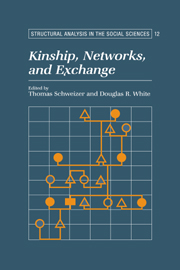Book contents
- Frontmatter
- Contents
- Preface
- List of contributors
- 1 Revitalizing the Study of Kinship and Exchange with Network Approaches
- I Representing Kinship Dynamics, Material Flow, and Economic Cooperation
- II Individual Embeddedness and the Larger Structure of Kinship and Exchange Networks
- 6 Experiential Flexibility of Cultural Models: Kinship Knowledge and Networks among Individual Khasi (Meghalaya, N.E. India)
- 7 Moral Economy and Self-interest: Kinship, Friendship, and Exchange among the Pokot (N.W. Kenya)
- 8 Risk, Uncertainty, and Economic Exchange in a Pastoral Community of the Andean Highlands (Huancar, N.W. Argentina)
- III Marriage, Exchange, and Alliance: Reconsidering Bridewealth and Dowry
- IV Emergence, Development, and Transformation of Kin-Based Exchange Systems
- Index
8 - Risk, Uncertainty, and Economic Exchange in a Pastoral Community of the Andean Highlands (Huancar, N.W. Argentina)
Published online by Cambridge University Press: 05 November 2011
- Frontmatter
- Contents
- Preface
- List of contributors
- 1 Revitalizing the Study of Kinship and Exchange with Network Approaches
- I Representing Kinship Dynamics, Material Flow, and Economic Cooperation
- II Individual Embeddedness and the Larger Structure of Kinship and Exchange Networks
- 6 Experiential Flexibility of Cultural Models: Kinship Knowledge and Networks among Individual Khasi (Meghalaya, N.E. India)
- 7 Moral Economy and Self-interest: Kinship, Friendship, and Exchange among the Pokot (N.W. Kenya)
- 8 Risk, Uncertainty, and Economic Exchange in a Pastoral Community of the Andean Highlands (Huancar, N.W. Argentina)
- III Marriage, Exchange, and Alliance: Reconsidering Bridewealth and Dowry
- IV Emergence, Development, and Transformation of Kin-Based Exchange Systems
- Index
Summary
INTRODUCTION
In economic anthropology and cultural ecology in recent years, there has been an increase of interest in the analysis of decisions made under risk and uncertainty conditions (for a general view see Barlett 1980; Cashdan 1990a; DeGarine & Harrison 1988; Halstead & O'Shea 1989). In spite of this effort, there is still no clear consensus in the literature about how risk and uncertainty should be precisely defined. However, Cashdan (1990b: 1, 2) proposes a definition which condenses the main uses of both terms. I will follow her definition in this analysis of trade; “risk” will designate unpredictable fluctuations in the ecological and economic conditions (objective probabilities) and “uncertainty” will refer to situations in which the actors are insufficiently informed about the socioeconomic conditions of the trade (subjective probabilities).
In contrast to traditional macroeconomics, approaches which take into account risk and uncertainty do not proceed from the assumption that actors can accurately predict the occurrence of an event. A basic supposition is that in their decision making, the actors have to consider estimations of probabilities about the consequences of their actions. This means that pure maximization of utility (e.g., maximization of production outcomes or of exchange rates) is not the principal aim underlying their decisions; but this maximization also takes into account risk and uncertainty factors (Cashdan 1990b: 2–6).
- Type
- Chapter
- Information
- Kinship, Networks, and Exchange , pp. 158 - 178Publisher: Cambridge University PressPrint publication year: 1998
- 4
- Cited by

